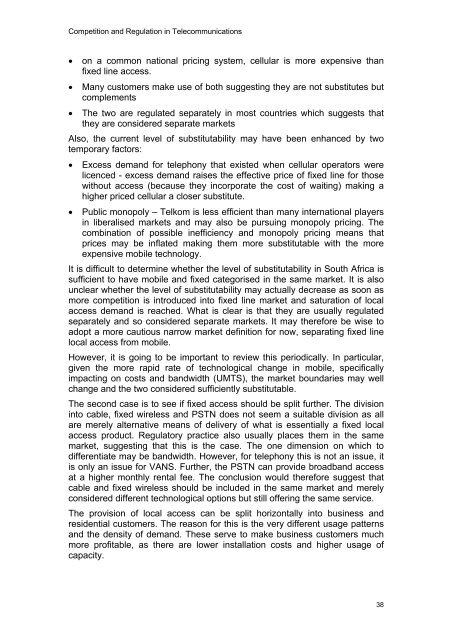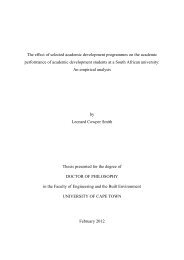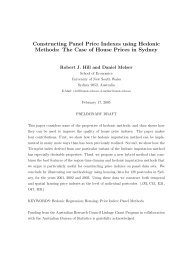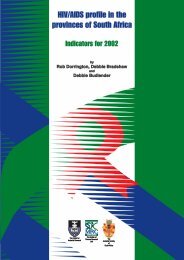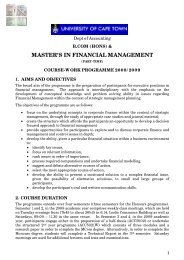Competition and Regulation in the Telecommunications Industry in ...
Competition and Regulation in the Telecommunications Industry in ...
Competition and Regulation in the Telecommunications Industry in ...
You also want an ePaper? Increase the reach of your titles
YUMPU automatically turns print PDFs into web optimized ePapers that Google loves.
<strong>Competition</strong> <strong>and</strong> <strong>Regulation</strong> <strong>in</strong> <strong>Telecommunications</strong>• on a common national pric<strong>in</strong>g system, cellular is more expensive thanfixed l<strong>in</strong>e access.• Many customers make use of both suggest<strong>in</strong>g <strong>the</strong>y are not substitutes butcomplements• The two are regulated separately <strong>in</strong> most countries which suggests that<strong>the</strong>y are considered separate marketsAlso, <strong>the</strong> current level of substitutability may have been enhanced by twotemporary factors:• Excess dem<strong>and</strong> for telephony that existed when cellular operators werelicenced - excess dem<strong>and</strong> raises <strong>the</strong> effective price of fixed l<strong>in</strong>e for thosewithout access (because <strong>the</strong>y <strong>in</strong>corporate <strong>the</strong> cost of wait<strong>in</strong>g) mak<strong>in</strong>g ahigher priced cellular a closer substitute.• Public monopoly – Telkom is less efficient than many <strong>in</strong>ternational players<strong>in</strong> liberalised markets <strong>and</strong> may also be pursu<strong>in</strong>g monopoly pric<strong>in</strong>g. Thecomb<strong>in</strong>ation of possible <strong>in</strong>efficiency <strong>and</strong> monopoly pric<strong>in</strong>g means thatprices may be <strong>in</strong>flated mak<strong>in</strong>g <strong>the</strong>m more substitutable with <strong>the</strong> moreexpensive mobile technology.It is difficult to determ<strong>in</strong>e whe<strong>the</strong>r <strong>the</strong> level of substitutability <strong>in</strong> South Africa issufficient to have mobile <strong>and</strong> fixed categorised <strong>in</strong> <strong>the</strong> same market. It is alsounclear whe<strong>the</strong>r <strong>the</strong> level of substitutability may actually decrease as soon asmore competition is <strong>in</strong>troduced <strong>in</strong>to fixed l<strong>in</strong>e market <strong>and</strong> saturation of localaccess dem<strong>and</strong> is reached. What is clear is that <strong>the</strong>y are usually regulatedseparately <strong>and</strong> so considered separate markets. It may <strong>the</strong>refore be wise toadopt a more cautious narrow market def<strong>in</strong>ition for now, separat<strong>in</strong>g fixed l<strong>in</strong>elocal access from mobile.However, it is go<strong>in</strong>g to be important to review this periodically. In particular,given <strong>the</strong> more rapid rate of technological change <strong>in</strong> mobile, specificallyimpact<strong>in</strong>g on costs <strong>and</strong> b<strong>and</strong>width (UMTS), <strong>the</strong> market boundaries may wellchange <strong>and</strong> <strong>the</strong> two considered sufficiently substitutable.The second case is to see if fixed access should be split fur<strong>the</strong>r. The division<strong>in</strong>to cable, fixed wireless <strong>and</strong> PSTN does not seem a suitable division as allare merely alternative means of delivery of what is essentially a fixed localaccess product. Regulatory practice also usually places <strong>the</strong>m <strong>in</strong> <strong>the</strong> samemarket, suggest<strong>in</strong>g that this is <strong>the</strong> case. The one dimension on which todifferentiate may be b<strong>and</strong>width. However, for telephony this is not an issue, itis only an issue for VANS. Fur<strong>the</strong>r, <strong>the</strong> PSTN can provide broadb<strong>and</strong> accessat a higher monthly rental fee. The conclusion would <strong>the</strong>refore suggest thatcable <strong>and</strong> fixed wireless should be <strong>in</strong>cluded <strong>in</strong> <strong>the</strong> same market <strong>and</strong> merelyconsidered different technological options but still offer<strong>in</strong>g <strong>the</strong> same service.The provision of local access can be split horizontally <strong>in</strong>to bus<strong>in</strong>ess <strong>and</strong>residential customers. The reason for this is <strong>the</strong> very different usage patterns<strong>and</strong> <strong>the</strong> density of dem<strong>and</strong>. These serve to make bus<strong>in</strong>ess customers muchmore profitable, as <strong>the</strong>re are lower <strong>in</strong>stallation costs <strong>and</strong> higher usage ofcapacity.38


